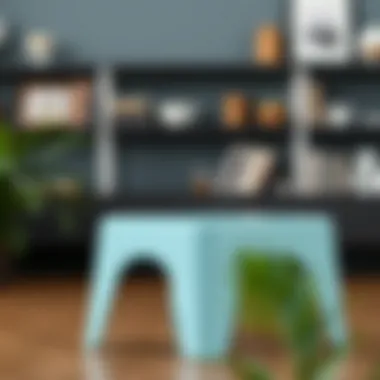Essential Insights on Flat Step Stools for Every Space


Intro
Flat step stools are often overlooked, but their role in enhancing both functionality and design in various settings is paramount. Whether it’s reaching for that elusive kitchen jar or giving little ones a boost to wash their hands, these stools serve practical purposes far beyond their humble appearance. The beauty of flat step stools lies not just in their convenience but in the diverse designs and materials that enable them to blend seamlessly into any environment.
In homes, offices, and even shops, these pieces can enhance the aesthetic integrity of a space while providing invaluable functionality. This comprehensive guide will break down design trends, buying advice, and important safety considerations when selecting the right flat step stool for your needs. Expect insights that stretch from traditional wooden options to sleek metal designs, and consider how each can elevate or complement your current decor.
Whether you’re a passionate DIY enthusiast, a retailer scouting for the latest trends, or a homeowner seeking practical solutions, this article aims to enrich your knowledge about flat step stools, ultimately guiding you to make informed decisions. By the end, you'll understand how to choose wisely, ensuring that your selected stool not only looks good but also serves its purpose effectively.
Understanding the landscape of flat step stools is akin to mastering an art form; there's a balance to strike between utility and style. Let's delve into the current design trends that are shaping the way we view these functional pieces in our everyday lives.
Prologue to Flat Step Stools
Flat step stools play a crucial role in both functional and aesthetic contexts, allowing individuals to reach heights that would otherwise be unattainable without the use of ladders or chairs. They embody a blend of utility and design, catering to diverse environments, from cozy home settings to bustling commercial spaces. Understanding their importance begins with recognizing their omnipresence in everyday life.
Homeowners especially find these tools indispensable; whether you’re grabbing something from a high shelf or reaching the top of a window to clean, flat step stools make those tasks much more manageable.
For designers, choosing the right stool can enhance the overall look of a space, turning what is often a mundane necessity into an eye-catching feature. The various designs available mean that you can find a stool that not only meets your height needs but also complements your decor style—be it sleek and modern or rustic and traditional.
From a practicality standpoint, flat step stools come in various shapes, sizes, and materials, ranging from wood to metal and even plastic. Each variation serves different functions and caters to specific needs, ensuring that no matter what situation you find yourself in, there’s always an appropriate option.
The benefits extend beyond mere height access; using a flat step stool can promote safety by preventing accidents that might occur from awkward stretches or climbing on unstable objects. When designed with thoughtful features such as non-slip surfaces and sturdy construction, step stools can provide a safe and reliable platform.
Moreover, contemporary life often sees a mix of functionality and style, and flat step stools represent this blend effectively. They are not purely utilitarian; many come in stylish designs that serve as decor elements while remaining practical.
In summary, flat step stools are more than just ladders; they embody a solution that meets various needs across different environments. As we delve deeper into this guide, we will explore historical contexts, design variations, material considerations, uses, safety aspects, and tips on selecting the right flat step stool for you. By recognizing their importance, we lay the groundwork for understanding how these simple yet effective tools can significantly enhance our everyday lives.
Historical Context and Evolution
Understanding the historical context and evolution of flat step stools offers a fascinating lens through which to appreciate their design and functionality today. This aspect reveals how these humble tools have transitioned from simple, utilitarian objects to stylish and indispensable items in modern homes and workplaces. Knowing the background can help homeowners and designers make informed decisions when selecting the right step stool, ensuring a blend of practicality with aesthetics.
Origins of Step Stools
The origins of step stools can be traced back thousands of years when early humans had to find ways to reach higher places. The first iterations were likely rudimentary platforms made from natural materials like wood or stone. Ancient Egyptians, for example, used step stools in their temples and tombs, crafted from robust materials to bear the weight of workers reaching for the intricate frescoes and carvings high up.
Over the centuries, various cultures adapted and modified the design to fit their needs. For instance, in ancient Rome, the concept of the step stool evolved into more decorative forms, often used by the affluent to access their elevated seating areas or cabinets that contained precious items. Innovations reflected the local trends and materials, but the core purpose—offering extra height and accessibility—remained unchanged.
Transition Through Eras
As we move through history, step stools continually adapted to match societal changes and technology advancements. During the Middle Ages, the functionality of flat step stools was crucial in households where space was limited. They served not only as tools for reaching shelves but also doubled as seating or storage solutions. This multi-functionality reflects a practical mindset common in that era.
In the 18th and 19th centuries, with the rise of the Industrial Revolution, materials became more diverse. Metal and formal wood crafting techniques enhanced durability and aesthetic value. Moreover, designs became increasingly ornate, leading to the introduction of collapsible models that catered to the growing trend of smaller living spaces.
Today, we see a remarkable blend of the old and the new. Contemporary flat step stools often incorporate elements from various historical designs, while also utilizing modern materials that ensure safety and stability. The emphasis on aesthetics has also never been higher, with options available that suit every decor style—from rustic farmhouse to sleek modern.
"Each step stool tells a story, reflecting the culture and needs of its time, while continuing to serve the essential purpose of making the inaccessible reachable."
A comprehensive understanding of this historical context not only ignites appreciation for flat step stools but guides readers in selecting the right one—balancing functionality with design elements that respect both the past and the present. Recognizing the journey these items have taken equips us with the insight needed to make wise choices today.
Design Variations in Flat Step Stools
When it comes to flat step stools, design variations play a crucial role in meeting diverse user needs and preferences. The right design can enhance both functionality and aesthetic appeal within various settings, from cozy kitchens to bustling workspaces. Understanding these variations allows homeowners, designers, and DIY enthusiasts to find a stool that both fits their style and serves their practical requirements.
Contemporary Designs
Contemporary flat step stools are often characterized by sleek lines and minimalist features. They tend to incorporate materials like metal and molded plastics, giving them a modern flair that can seamlessly blend into any design scheme. A significant advantage of these designs is their lightweight nature, making them easy to move around while providing sufficient stability.
For instance, a contemporary stool crafted from aluminum may sport a matte finish, layering the space with a touch of sophistication. These stools can also come with added features, like anti-slip rubber feet or a foldable frame, ensuring that safety and convenience are paramount. Their aesthetic appeal often comes from innovative shapes and colors, allowing users to express their personality while enjoying the practicality of a flat step stool.
Traditional Designs
In contrast, traditional flat step stools evoke warmth and nostalgia. Often constructed from solid wood like oak or maple, they bring an earthy tone into a home. Their designs can range from ornate carvings to simple, rustic outlines. A well-crafted wooden step stool can be more than just a functional item; it can become a statement piece in a room, capturing the attention of any visitor.
An example of a traditional design is the classic three-step stool, often found in farmhouses or country cottages. Its robust construction and sturdy ladder-like structure invite users to ascend with confidence, whether for reaching a high shelf or simply enjoying a moment of elevated perspective. Furthermore, these designs can be refinished or painted, allowing for personalization that can reflect evolving tastes over time.
Multi-functional Options
Many flat step stools today embrace the multi-functional concept, easily transitioning between various roles within a household. These designs are particularly appealing to those living in smaller spaces or anyone keen on maximizing utility without sacrificing style.
A standout example of this is the step stool that doubles as a storage unit. Such designs often include compartments for stowing away tools or cleaning supplies, ensuring that when not in use, the stool contributes positively to the overall organization of a room. Another innovative idea comes in the form of stools that can convert from a flat step stool into a side table or a plant stand.
"Multi-functional flat step stools allow for creative solutions in limited spaces, transforming practicality into style with ease."
Material Considerations


When selecting a flat step stool, the choice of material plays a crucial role that goes beyond mere aesthetics. The material influences not just the visual appeal but also the practicality, longevity, and safety of the stool. Here, we will explore the advantages and potential drawbacks of various materials, helping consumers make informed decisions that suit their needs and environments.
Wooden Step Stools
Wooden step stools evoke a sense of warmth and timelessness. Their sturdy construction and aesthetic charm make them a favorite in homes that embrace a natural or rustic decor.
- Durability: Quality wood, such as oak or maple, is both strong and resilient, providing a robust option that can withstand daily use.
- Aesthetic Appeal: The natural grains and finishes of wood add a touch of elegance to any space, making these stools not just functional but also decorative.
- Considerations: However, wooden stools may require regular maintenance to prevent wear from humidity and changing temperatures. They tend to be heavier compared to their plastic or metal counterparts, making portability a bit cumbersome.
Metal Step Stools
Metal step stools, often crafted from aluminum or steel, are lauded for their strength and contemporary look. They cater well to both industrial settings and modern homes.
- Strength and Stability: Metal offers exceptional durability and support, handling heavier loads without faltering. This makes them suitable for commercial spaces where usage can be intense.
- Lightweight Options: Aluminum, in particular, can provide a lightweight alternative, making these stools easier to move around.
- Rust and Corrosion: One downside to metal stools is their vulnerability to rust, particularly if used outdoors or in humid environments. Special coatings might be necessary to protect against corrosion, so this is an important consideration for potential buyers.
Plastic and Composite Materials
Plastic and composite step stools have surged in popularity, largely due to their versatility and affordability. In many cases, they offer a reliable option for those seeking lightweight and durable solutions.
- Lightweight and Portable: The biggest draw is their ease of movement, which is especially beneficial for those who need to shift stools between spaces frequently.
- Convenience: These stools are often easy to clean and maintain, as they typically resist stains and can endure wet conditions without suffering damage.
- Durability Concerns: On the flip side, some plastic stools may not offer the same level of stability as wooden or metal options. Their strength varies widely, and consumers should pay attention to weight limits and construction quality before purchasing.
"Choosing the right material in flat step stools can influence not only the safety and comfort of the user but also how well the stool fits into the space it is designed for."
In summary, understanding the material considerations for flat step stools is essential. Whether opting for wooden charm, industrial metal, or modern plastic, each material offers distinct benefits and potential challenges. By aligning the material choice with personal needs and environmental compatibility, homeowners, designers, and DIYers can ensure they select the most effective and visually appealing stool for their space.
Practical Uses of Flat Step Stools
Flat step stools serve a variety of purposes across different domains—from the cozy confines of home to bustling commercial establishments and lush gardens. Their role extends beyond mere utility; they embody a blend of accessibility, efficiency, and, occasionally, style. In this section, we break down the significance of flat step stools, spotlighting their practical applications and the distinct advantages they bring to specific environments.
Home Applications
In the home environment, flat step stools can often be seen tucked away in corners or strategically positioned in high-traffic areas. These handy tools are great for reaching those hard-to-access spaces. Whether you need to grab a book from a towering shelf, change a light bulb, or retrieve items from high kitchen cabinets, a flat step stool simplifies tasks around the house.
Consider the benefits that homeowners often find:
- Increased Reach: A flat step stool enables individuals of shorter stature to access high places without resorting to dangerous improvised methods.
- Space Efficiency: Many flat step stools are designed to be slim and easy to store. They can be placed behind a door or under a bed when not in use, avoiding clutter.
- Decor Compatibility: With a variety of designs available, they can be chosen to match home decor, providing a practical yet visually pleasing solution.
Commercial Applications
Shifting gears to commercial settings, flat step stools play an equally vital role. Retail spaces, warehouses, and office buildings often rely on these stools for a seamless workflow. For instance, employees in retail can use them to arrange merchandise that’s hard to reach, while warehouse staff may rely on them for stock retrieval on higher shelves.
Notably, the commercial advantages include:
- Workplace Safety: Using a step stool designed for commercial use can mitigate accidents associated with reaching, as they provide a sturdy base.
- Time Efficiency: Task completion is swift when the right tools are available. A flat step stool can help personnel save minutes—time that can be crucial in a busy environment.
- Durability: Commercial flat step stools are often made from sturdier materials compared to their residential counterparts, ensuring they endure heavy use over prolonged periods.
Gardening and Outdoor Use
Besides indoor functionality, flat step stools shine in outdoor applications, particularly in gardening. Many gardening enthusiasts take advantage of these stools for an array of tasks, from potting plants to general yard maintenance. The outdoor environment can present its own set of challenges, and a step stool becomes an indispensable ally.
Key aspects of outdoor use include:
- Comfortable Gardening: A flat step stool can serve as a makeshift seat, providing relief during those long hours spent toiling in the soil.
- Planting Efficiency: Reaching into raised beds or higher planters is a breeze, thus preventing strain or injury—something that regular gardeners surely appreciate.
- Lightweight and Portable: Many outdoor-specific stools are designed to be lightweight, allowing gardeners to easily transport them from one area to another without breaking a sweat.
Such diverse utility underscores the flat step stool’s importance. From homes to businesses and outdoor spaces, their capacity to enhance accessibility and promote safety can’t be overstated.
"A well-chosen step stool is more than a utility item; it's a facilitator of productivity and safety in both domestic and commercial landscapes."
Safety Considerations
When it comes to selecting a flat step stool, ensuring safety should be at the forefront of your mind. These handy tools can make a visible difference in our lives, whether you're reaching for those high shelves in the kitchen or changing a light bulb. However, without proper safety measures, they can pose risks that aren't immediately evident. From stability to material grip, there are specific aspects to consider when choosing a stool to make sure it serves its purpose without compromising personal safety.
Weight Limits and Stability
Understanding the weight limits of any step stool is crucial before you even think about using it. Each stool is designed to hold a maximum weight, which is usually clearly marked. Ignoring this can lead to serious mishaps. For instance, a wooden stool often has its own limit depending on its construction quality, while metal stools generally offer more strength and stability.
To ensure stability, look for the following features:
- Wider Base: A stool with a wider base provides a greater center of gravity, reducing the risk of tipping over.
- Step Tread Design: Some stools have textured surfaces; these can enhance grip and help prevent slips.
- Material Quality: A well-constructed stool from sturdy materials like aluminum or hardwood will better withstand various weights.
"Safety is not just what you do; it’s what you don’t do. Taking appropriate steps means avoiding unnecessary risks."
Surface Material and Grip
The surface material of your flat step stool is not just about aesthetics. It plays a pivotal role in how safe it is during use. Consider these factors:
- Textured Surfaces: Opt for stools with non-slip textured surfaces. These surfaces help provide traction, reducing the chances of slipping.
- Rubber Feet: Look for stools with rubber feet to ensure they won't easily slide across the floor, especially on smooth surfaces.
- Material Type: Each material can behave differently; for example, plastic might become slippery in wet conditions, while wood may provide excellent grip but require regular maintenance to retain that quality.


Testing a stool under dry and wet conditions can be helpful. After all, accidents sometimes happen when you least expect them, and knowing how your stool handles differing conditions might interest DIYers or home enthusiasts.
Best Practices for Use
Even the best step stool could cause accidents if it’s not used properly. Here are some recommended best practices to follow when using your flat step stool:
- Inspect the Stool Before Use: Before climbing up, give your stool a quick visual check. Look for any signs of wear or damage that may compromise its stability.
- Place on a Level Surface: Always position your stool on a flat, stable surface. Uneven ground or slippery floors can lead to disaster.
- Face Forward: When standing on the stool, always face the stool, keeping your center of gravity aligned with it. Avoid reaching too far away.
- Don’t Overreach: If you find yourself straining to grab something, it’s better to safely step down and reposition rather than risk a fall.
- Keep the Area Clear: Keep your workspace free from clutter to avoid tripping hazards while you’re climbing up or down.
By following these safety considerations, you can maximize your utility from flat step stools while minimizing risks. Treating these tools with the caution they deserve makes them a reliable asset in both home and professional settings.
Choosing the Right Flat Step Stool
Selecting the right flat step stool is an important desision for anyone looking to enhance their living or working spaces. These simple yet effective tools can make a world of difference in terms of functionality and convenience. The process involves assessing what you truly need from a step stool, considering how it will fit in with your existing decor, and understanding the financial implications of your choice. This guide aims to dive deep into the specific elements and benefits that come with this seemingly straightforward decision, making it clear why every step stool matters.
Assessing Your Needs
When choosing a flat step stool, it’s essential to reflect on your specific needs. This isn’t merely about convenience; it’s about functionality that matches your lifestyle. Consider the tasks you’ll be performing. Are you reaching high shelves in your kitchen, changing light bulbs, or maybe accessing higher cabinets? Understanding these factors will help narrow down your search.
- Height Requirement: Evaluate how high you need to reach. A stool that’s too short won't do you any favors, and one that’s too tall might cause unnecessary risks.
- Weight Capacity: It’s crucial to check the weight limit. Sturdy stools can handle heavier loads, making them safe options for various activities.
- Frequency of Use: If your stool is going to be used daily, durability becomes a key factor. For occasional tasks, a lighter, perhaps less expensive option may suffice.
Ultimately, knowing the layout of your space and how often you use a step stool will greatly guide you in making the right choice.
Style Matching with Your Decor
Once you've assessed your needs, it's time to think about aesthetics. A flat step stool, while practical, also serves as a design element in your home or workplace. You wouldn’t want a mismatched eyesore in your living area. Consider these elements:
- Color Schemes: Does it blend well with the existing color palette of your room? A stool in complementary hues can enhance the surrounding decor.
- Material and Finish: The texture and finish of the stool should also align with other furnishings. Wood accents? Go for a wooden stool. Sleek and modern decor? Think of a metal or plastic option.
- Size and Space: Measure your space to ensure the stool fits comfortably without overcrowding. A stool that’s too large may be cumbersome, while one that’s too small may not serve its purpose well.
An aesthetically pleasing choice encourages you to integrate the stool seamlessly within your environment, rather than viewing it as a separate and practical entity.
Budget Considerations
While function and aesthetics are key, budget considerations are often the driving force behind many purchasing decisions. Flat step stools are available across a broad range of price points, so understanding how much you're willing to spend is beneficial.
- Quality vs. Cost: Low-cost stools may compromise on quality; hence investing a little more often leads to better safety and longevity. A high-quality stool can save you money in the long run.
- Special Features: Adjustable heights or additional storage options can also affect the cost. Determine what features are important for your needs before making a decision. Some brands might entice consumers with lower prices, but hidden costs could arise in replacements or repairs.
- Sales and Discounts: Keep an eye out for seasonal sales or clearance events at home improvement stores. You might snag a quality stool at a much lower price.
Overall, setting a budget ensures you don’t fall into impulse buying traps, while still finding a flat step stool that fits within your desired parameters. With these aspects in mind, you’ll be well-prepared to choose the right flat step stool that meets your needs, enhances your space, and aligns with your financial considerations.
"A step stool is not just a tool; it’s an accessory for your home’s practicality and style. Choose wisely."
Care and Maintenance
Taking proper care of flat step stools ensures their longevity and functionality. Given their diverse materials and frequent use in both homes and workplaces, having a thorough understanding of care and maintenance is crucial. When these stools are well maintained, they not only preserve their aesthetic appeal but also enhance safety during use. Neglecting maintenance can lead to wear and tear, which impacts both the visual integrity and structural stability of the stool. Therefore, regular upkeep can save you from potential safety hazards, and costly replacements down the line.
Cleaning Techniques by Material
The approach to cleaning flat step stools largely depends on their material. Here are some techniques for various types:
- Wooden Step Stools:
Wood requires gentle treatment to keep its finish looking fresh. A soft cloth dampened with warm water and a mild soap is ideal. Avoid soaking the wood, as excessive moisture can warp it. After cleaning, dry the surface immediately with a clean towel to prevent any moisture absorption. - Metal Step Stools:
For metal stools, a mixture of vinegar and water can be effective in removing grime and rust. Wipe with a microfiber cloth and follow with a dry cloth to prevent any oxidation. Regular inspections for scratches and rust will also prolong the life of metal structures, allowing for early intervention when needed. - Plastic and Composite Materials:
Plastic can be easily cleaned with a solution of warm soapy water and can handle a little scrubbing without damage. For tougher stains, a non-abrasive cleaner works wonders. Additionally, they are usually resistant to moisture, making cleaning quite straightforward.
Regardless of the material, always remember to check for any loose parts or damage during cleaning, ensuring everything remains safe and sound.
Storage Recommendations
Where you store your flat step stool can significantly influence its lifespan. Here are some recommendations to keep in mind:
- Indoors:
If possible, keep your stool indoors, away from excessive sunlight and moisture. This helps to maintain its integrity and looks. If you must store it outside, consider using a protective cover to shield it from the elements. - Proper Position:
Always store the stool in an upright position when not in use. Laying it flat can warp the legs or cause unnecessary strain on the joints. - Away from High Traffic Areas:
Avoid placing it in areas where it could easily be knocked over or run into. An unintentional bump can lead to damage that may not be immediately apparent.
A good rule of thumb is to ensure that your step stool is stored in a designated space, where it can be easily accessed, yet safe from accidental damage.
Overall, thoughtful care and appropriate storage of flat step stools ensure they serve their purpose effectively while contributing to the overall safety and aesthetic of your living or working environment.
Comparative Analysis of Popular Brands
When it comes to selecting a flat step stool, delving into the offerings of various brands can make all the difference. Each manufacturer brings its unique flair, design ethos, and range of functionalities. An informed decision hinges on comparative analysis, shedding light on features that resonate with the consumer's specific needs. By examining the various characteristics such as durability, usability, aesthetics, and customer feedback, we can aim for a quality purchase that stands the test of time.
Ranging from innovative designs to user-centric features, the comparison doesn't just enlighten prospective buyers on their options; it also helps them navigate between price points while considering value for money. In a market brimming with choices, identifying the standout brands helps homeowners, designers, retailers, and DIY enthusiasts hone in on the most suitable flat step stool for their spaces.
Brand A Overview
Brand A is renowned for its striking balance between aesthetics and functionality. Constructed primarily from solid wood, their step stools feature a smooth finish that complements both modern and traditional interiors. The attention to detail in craftsmanship makes them visually appealing, while their robust build ensures stability for various tasks. One highlight is their non-slip grip, which enhances safety, particularly for users who might be scaling higher shelves. Customer feedback frequently praises the sturdy design and ease of maintenance, which is a significant consideration for many buyers.
Brand B Overview


In stark contrast, Brand B opts for a modern approach by employing industrial-grade metal in their step stools. This choice delivers unparalleled strength while maintaining a sleek, minimalist appearance. Often favored for commercial applications, these stools are praised for their thickness and weight capacity, catering to environments that demand durability. Another standout feature is their stackable design, which is increasingly appealing for those with limited storage options. Users have highlighted the rust-resistant finish, ensuring the longevity of the product, making it an attractive consideration for gardeners and outdoor enthusiasts alike.
Brand Overview
Meanwhile, Brand C takes an innovative route by incorporating foldable elements into their flat step stools. This versatility is a significant selling point, particularly in compact living spaces where every inch counts. Made from high-quality plastics, these stools are lightweight yet surprisingly robust, eliminating the struggles often faced when transporting heavier wooden or metal alternatives. Many users appreciate the vibrant color choices, allowing individuals to showcase their personality, all while enjoying the stool’s practical utility. Consumer reviews indicate a high level of satisfaction, particularly pointing out how this brand’s designs cater to those seeking a balance between fun and function.
"Each brand brings its own unique touches—what works best for one person may not suit another. Taking time to compare features is crucial for making a well-informed purchase."
Innovations in Step Stool Design
When it comes to step stools, innovation plays a pivotal role in enhancing both functionality and style. In our advancing world, the traditional wooden or metal step stool has undergone a remarkable transformation. New technologies and design philosophies are now making these tools not just practical but also aesthetically pleasing additions to any space.
Innovations in step stool design focus on user experience, safety, and versatility. Understanding these elements is key for homeowners, designers, retailers, and DIY enthusiasts alike. It’s not only about getting to that high shelf anymore; it's about how these stools fit into modern living and working environments.
The benefits of adopting innovative designs are manifold. They can be tailored to meet specific needs—whether it’s for quick home renovations or creating ergonomic spaces in offices. For instance, smart step stools incorporate features that resonate with the contemporary lifestyle, providing both convenience and safety in one package.
"The evolution of flat step stools reflects how functional accessories can adapt to modern demands while holding true to their purpose."
Smart Step Stools
Smart step stools take the concept of functionality to a whole new level. Imagine a stool that not only helps you reach higher places but also tracks your usage, or perhaps has built-in storage for tools and supplies. These advanced designs often integrate tech features like sensors that assess stability or weight thresholds, ensuring safer usage.
Many have a compact design which folds neatly for storage, ideal for urban living where space is at a premium. Some models come with LED lights, providing visibility in low-light conditions, thereby enhancing safety during nighttime access. The design isn't just practical; it also appeals to tech-savvy users who appreciate gadgets that make life easier.
Considerations when choosing smart step stools:
- Weight sensor alerts: Helps avoid overloading.
- Smart storage compartments: Useful for organizing frequently-used items.
- Stability indicators: Visual or auditory signals to ensure safe use.
Adjustable Heights
Adjustable height step stools cater to a variety of needs. Whether it’s for children needing assistance in the kitchen or adults reaching high shelves, these versatile tools can be customized for different tasks. The flexibility of height adjustment means they can accommodate individuals of varying heights and preferences, promoting safety and comfort.
Many designs incorporate a locking mechanism to secure the chosen height, further ensuring the user’s confidence while in use. The design innovation allows for a single stool to serve multiple purposes across different areas of the home or workplace, making it an economically sound choice.
Advantages of adjustable height stools:
- Versatile usage: Adaptable for various tasks.
- Enhanced safety features: Minimized risk of accidents with stable height settings.
- Space-saving design: Reduces the need for multiple stools.
In summary, innovations in step stool design reflect a blend of functionality and aesthetic appeal. Smart technologies and adjustable heights are just two examples of how flat step stools are evolving, making them more useful than ever. By embracing these advancements, users can ensure they have the right tool for not just reaching higher places, but for enhancing their everyday experiences.
Environmental Considerations
In today's world, where sustainability is gaining momentum, it's essential to consider the environmental impact of every household item, including flat step stools. With increasing awareness of eco-friendly practices, the focus on environmental considerations becomes crucial not just for manufacturers, but also for consumers. Understanding these aspects encourages responsible purchasing and helps to minimize the ecological footprint associated with our choices.
Sustainable Materials
When selecting a flat step stool, one of the standout features consumers should look for is the material used in its construction.
- Wood: Often sourced from sustainably managed forests, wooden step stools can be a great choice. They add warmth and character to any room while being biodegradable. Opt for products labeled with certifications like FSC (Forest Stewardship Council) to ensure that the wood is sourced responsibly.
- Metal: Aluminum or steel are common materials in commercial-grade stools. Utilizing recycled metal reduces the demand for new raw materials and helps decrease energy consumption during production. Plus, metal step stools often have a longer lifespan, making them a durable option.
- Plastic and Composites: Nowadays, many flat step stools are made from recycled plastics or composite materials, which can significantly reduce environmental impact. While they may not have the classic look of wood, they can be surprisingly sturdy and are often designed to be easily recyclable at the end of their life.
A thoughtful selection of materials not only improves the functionality of flat step stools but also contributes to a more sustainable future. Consumers can play their part by leaning towards options produced with environmental care in mind.
End-of-Life Recycling Options
Considering what happens to a step stool at the end of its useful life is just as important as the materials used in its creation. Recycling options can vary significantly, so understanding one's options can make a big difference.
- Wooden Stools: Although it might be harder to recycle wooden stools completely, they can often be repurposed or used in DIY projects. Some communities host wood recycling programs where local businesses or individuals can reclaim materials for new projects.
- Metal Stools: These are generally easier to recycle. Most scrap yards and recycling centers accept aluminum and steel, providing a seamless option for disposal. The recycling process for metal involves melting it down and reusing it, which requires significantly less energy than producing new metal.
- Plastic Stools: Many recycling programs are now equipped to handle plastic furniture. Look for numbers on the bottom of the stool to identify the type of plastic, and check with local recycling resources to see if they accept that material. Furthermore, some companies are initiating take-back programs that allow customers to return old plastic stools for responsible disposal.
Embracing end-of-life recycling options not only diverts waste from landfills but also promotes a culture of sustainability. By being proactive about the disposal of step stools, consumers can contribute to a circular economy.
Closure
In closing, this guide has illuminated the multifaceted role of flat step stools, not only as practical tools but also as essential elements of aesthetic design in various environments. Homeowners, designers, retailers, enthusiasts, and DIYers can all benefit from understanding how to select and use these versatile accessories effectively.
Importance of Flat Step Stools
Flat step stools serve multiple purposes in the home and workplace, providing both safety and convenience. Their significance extends beyond mere functionality; they can complement interior decor while addressing the practical needs of reaching higher spaces.
Key Considerations
When choosing a flat step stool, several factors should be taken into account:
- Material: Selection based on durability and maintenance
- Design: Ensuring alignment with existing decor
- Safety Features: Weight limits and stability requirements
- Functional Needs: Based on intended usage, whether for home, commercial purposes, or outdoor tasks.
Final Thoughts
The right flat step stool can enhance how a space functions while merging style with practicality. Taking the time to consider the type and design of step stool best suited for specific needs is not just a consideration for looks, but for overall safety and efficacy in use.
"A flat step stool isn’t just a tool; it’s a bridge to the next level of your potential, whether that be in high reaching chores or high flying projects."
By applying the insights gleaned from this guide, readers can confidently navigate the choices available in the market, ensuring they select a flat step stool that fits seamlessly into their lives and enhances their spaces.















